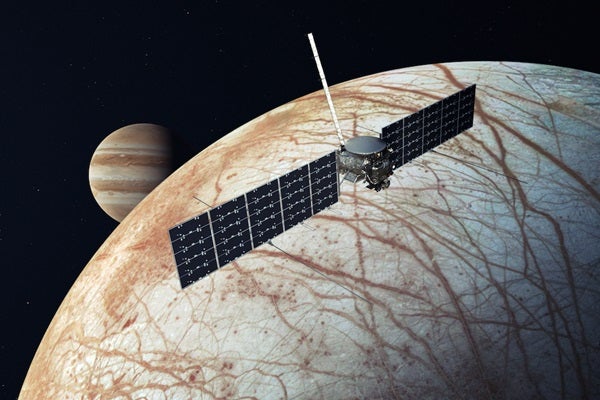NASA’s Europa Clipper spacecraft is scheduled for launch in 2024, carrying 10 instruments that will assess the habitability of Jupiter’s moon Europa. The craft will follow up on discoveries by the Galileo mission of the 1990s, which orbited Jupiter and made multiple flybys of both the planet and its major satellites. As you point out, Europa Clipper will orbit Jupiter. However, it will solely focus on Europa, performing some 50 close passes of the ocean-sporting moon during its primary mission.
So why will it orbit Jupiter and not Europa itself? One word: radiation. Jupiter’s powerful magnetic field traps and accelerates charged high-energy particles, producing a doughnut-shaped radiation belt that rotates with the planet. Europa orbits Jupiter within this high-radiation zone, and so is continuously exposed to this harsh environment. The radiation belt is damaging to spacecraft and instrument electronics, leading to rapid degradation if unaccounted for.
A 2011 NASA study assessed both a Europa-orbiting spacecraft and a Jupiter-orbiting “Multiple-Flyby Mission” option. Around Europa, an orbiting spacecraft would be limited to a lifetime of a mere one month due to this continuous radiation exposure. In contrast, the highly elliptical orbit of the multiple-flyby Europa Clipper mission means it will spend most of its time outside of the high-radiation zone, only being briefly exposed to it during its quick passes by the moon. As an added bonus, its long elliptical orbit also permits the craft to transmit collected flyby data back to Earth, as well as perform additional functions between Europa encounters (typically two to three weeks apart).
Europa Clipper’s multiple-flyby architecture will yield significantly more data than a Europa-orbiting mission, and cleverly designed trajectories will permit near-global high-resolution mapping. As of now, the Europa Clipper spacecraft is taking shape in “shipyard” facilities across the country and overseas. We hope you continue to follow the Europa Clipper mission as we proceed toward unprecedented science!










